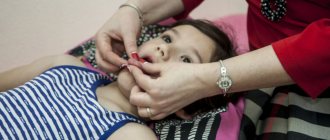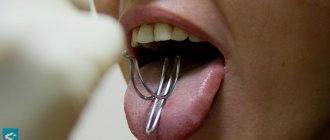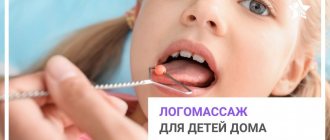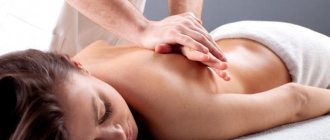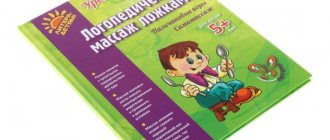The importance of speech development
The task of parents is to create conditions for children to begin communication development as early as possible, learn to exchange emotions, and perceive surrounding phenomena and things. For babies who cannot yet speak, a nonverbal method of communication is extremely important, allowing them to show emotions to the people around them without words. So, yawning is a signal for parents that the baby is tired, a smile is a signal that the baby is in a wonderful mood. When parents correctly respond to the baby’s nonverbal messages, they contribute to his development and accelerate the transition to verbal communication.
When a child talks aloud about surrounding objects and phenomena, his speech ability is actively developing. A growing child gains the skill of creating logical chains, thinking, and moving from reasoning to action. Parents should devote enough time to communicating with their children in a favorable environment, because this is the main condition for speech development.
With properly developed speech, children have:
- developed thought processes;
- active functioning of the nervous system;
- ability to read clearly and quickly and write correctly;
- the ability to correctly perceive incoming information;
- high ability to plan and learn;
- clear and concise presentation of thoughts.
Hand massage for children for speech development
If the baby is under three months old, this type of massage must be agreed upon with a neurologist. If there are no diseases or neurological disorders, the procedure comes down to stroking, rubbing and warming up each finger individually. After three months, objects with protrusions can be used. They need to be rolled in your hands. Such movements are carried out on both sides of the palms. You can use pencils, nuts, balls as objects. Equipment after a year:
- the baby must hook the fingers of the same name from different hands;
- the child holds his fingers tightly, the parent must separate them at this time;
- use the child’s hands to massage each finger;
- pinch your fingers between your middle and index fingers and stretch them out, at the same time completely twisting them.
In order for the child to understand how to carry out the movements, the parent must show and help the child himself.
Indications and contraindications
Probe speech therapy massage is used for:
- dysarthria - impaired pronunciation due to damage to the nervous system;
- rhinolalia - disturbances of articulation and voice due to defects of the speech apparatus;
- voice problems;
- stuttering;
- alalia motor type;
- dyslalia – defective sound pronunciation with normal hearing and articulatory apparatus.
Massage exercises are contraindicated if:
- vomiting syndrome;
- inflammatory reaction in the nasopharyngeal area;
- mechanical damage to the tongue;
- blood pathologies of any origin;
- infectious damage to the body;
- tendency to allergies, accompanied by swelling of the mucous membranes;
- diseases whose symptoms are seizures;
- the patient’s oral cavity is injured or affected by fungus;
- open wounds on the hands of the massage therapist.
Types of speech therapy massage
Speech therapy massage comes in several types:
- Classic or manual. It is carried out by smoothing, rubbing, kneading, shaking the problem area or the area around it.
- Spot. The specialist acts on bioactive points that are associated with problematic speech areas.
- Hardware. Involves the use of a vibration device.
- Probe. The impact is carried out through special devices - probes.
- Self-massage. The patient massages the problem areas independently.
Probe speech therapy massage
Massage carried out through probes helps prevent the worsening of speech impairment, prevents underdeveloped hearing, inhibition of gaining experience in vocabulary analysis, and a low level of vocabulary. After a course of procedures using probes:
- correct sound pronunciation is given;
- the tone of the articulatory muscles is restored;
- voice improves;
- breathing is normalized during pronunciation;
- the patient's psycho-emotional state improves.
Tool processing
Each set of tools is used once. Afterwards, it is soaked in a disinfectant solution, without removing it from it, and treated with cotton swabs for 30 seconds.
Then the instruments are washed under running water using such products as “Progress”, “Biolot”, “Astra”. Do this for 10 minutes.
The probes are washed in distilled water for 30 seconds. Finally, it is dried in a dry oven.
This is a standard method for sterilizing medical instruments. You cannot neglect it, as this is a violation of the law. Children may have various diseases; in the event of mass infection, there will be serious checks and investigations.
Probe tongue massage
Massage of the tongue with probes lasts 5 minutes and is carried out several times a day. Before the procedure, it is advisable to do gymnastics to warm up the tongue muscles, including the following exercises:
- Swing. The tongue is stuck out and moved from one corner of the mouth to the other. The mouth is kept open.
- Watch. They open their mouth, lick their lips with their tongue in a circle in different directions.
- The lips stretch into a smile and the mouth opens. The tongue is placed on the lower lip and the air begins to blow out vigorously.
- Horse. Perform clicking movements with the tongue. The lower jaw should not move.
- Drummer. The lips are pulled into a smile, the mouth is parted. The tongue taps the edges of the upper incisors.
General recommendations for conducting
The duration of the course is calculated individually. On average, 10 procedures performed every other day are sufficient. Between cycles there is a break of a month. Some speech therapists prefer to include massage before each session.
The duration of the procedure depends on:
- from age;
- degree of defect;
- personal characteristics.
The minimum time is 5 minutes, the maximum is 25. The impact should not cause pain, slight discomfort is allowed. Children may be afraid of probes because they resemble medical instruments. You can let them touch them, play with them, or have a session with toys.
In case of negativism, hysterics, aggression, the first sessions are kept as short as possible. Start by stroking the lips, cheeks, and tip of the tongue. With a pronounced gag reflex, the effect begins with a light one, gradually moving deeper into the mouth.
Massage sessions are carried out in a well-ventilated area. It should be warm, bright, cozy.
Logomassage for children at home
Massage that promotes speech development can be done at home. Parents should consult a speech therapist about exercise techniques and contraindications.
At home, massage the face and tongue with fingers and teaspoons, and perform breathing and articulation exercises.
Facial massage is based on smoothing, rubbing, kneading, which should not cause discomfort to the patient. Facial massage has a step-by-step technique:
- The forehead is smoothed from the middle to the temples, from the brow ridges to the ears. Then knead with light movements.
- The cheeks are wrinkled and stretched from the corners of the lips to the temples, from the cheekbones to the chin.
- The nose is smoothed and stretched with light movements. Then stroke the area from the wings of the nose to the corners of the lips.
- The lips are smoothed, stretched from the middle to the corners.
- The chin is smoothed from the middle to the corners of the mouth.
- The neck is stimulated with smoothing and kneading movements.
Today, speech therapy facial massage with spoons is popular. It is also carried out in stages. Masseur with spoons:
- Strokes the patient's temples.
- Strokes the eye socket area.
- Smoothes the cheeks.
- He rubs his temples with the convex surface of spoons.
- Rubs the area between the eyebrows with the convex surface of the cutlery.
- He rubs the nasolabial folds with the handles of the devices.
- Strokes lips with slight pressure.
- Kneads cheekbones and chin.
Spoons should be taken without sharp edges or bulges so as not to scratch the patient’s skin.
Advantages and disadvantages of the technique
Probe massage allows you to speed up the production of sounds, facilitate the assimilation of articulatory gymnastics, and improve muscle function. Without it, correction of dysarthria will take 5-10 years.
It does not require special conditions, since it can be done by any speech therapist with the appropriate qualifications. In many correctional institutions, it is carried out by specialists as needed.
Massage helps relieve tone, hypersalivation, and improve fine motor skills.
It also has disadvantages. The significance and value of massage is overestimated - it is an auxiliary tool, not a panacea. Low-qualified speech therapists provide probe massage as a cure for all problems. In fact, the impact only provides the basis for producing sounds, which does not cancel the remaining stages of the work.
If used incorrectly, tools cause negativity in the child, since if they are not understood, they can cause serious harm. Some specialists act rudely and incorrectly, which leads to pain and the child’s refusal to study.
Novikova’s technique with non-speaking children
Most often, probes for speech therapy massage are used for dysarthric disorder, when the patient experiences great difficulty in pronouncing sounds. The probe type of massage was developed by the famous speech therapist Elena Viktorovna Novikova. The procedure is carried out using eight devices of different configurations, called probes.
Each probe is used for speech therapy massage for a specific purpose, affecting a specific area that needs correction. The specialist determines which area requires correction and with what force it needs to be pressed. The main thing is that the patient should not experience pain. If muscle hypertonicity is eliminated, the patient may feel slight muscle tension. In this case, to ease the discomfort, you should sit the baby in a soft seat or lay it on a comfortable surface.
Probe procedures correct speech technique and provide:
- voice improvement;
- normalization of conversational breathing;
- restoration of the psyche and state of the nervous system;
- tone of speech muscles;
- formation of correct sound pronunciation.
Speech production according to Novikova is technically simple and shows high efficiency. The specialist has developed a technique so that each probe stimulates a specific area of the articulatory apparatus: lips, tongue, cheeks, soft palate. During the procedures, these areas are restored.
The massage therapist pays attention to the condition of the patient’s facial muscles. Based on the level of muscle damage, the specialist prescribes the number of procedures necessary to normalize the condition.
Massage tools and technique
Massage should be trusted to a highly qualified and experienced specialist. It is advisable to use high-quality and safe probes from reputable companies. Parents must take their child to each procedure, and if classes are held at home, they cannot be missed.
The course of procedures lasts 2 – 3 weeks. After a 1.5-month pause, the course is resumed. The repetition of each exercise is 30 – 35 times. Sometimes one course is enough to normalize your speech. Children usually enjoy the procedures and do not experience any unpleasant sensations from the probes.
Massage therapists use the following speech therapy probes for massage:
- Forkhead (No. 1). The sharp end of the device is used to prick the tongue, lips, cheeks, and back wall of the mouth. As a result, the muscles begin to contract intensely. Gentle and gentle movements are made. After several sessions, the specialist may add rocking with the probe to the tingling sensation. The instrument is swung in different directions and in a circle for several seconds.
- Eight (No. 2). The instrument is designed to stimulate the lips, tongue and cheeks. The selected area of the body is rubbed from top to bottom and back using a loop-shaped base. The probe is not moved along the surface of the tongue, only pressure is applied to the organ and the loop on it is swung.
- Sleds (No. 3 – large, No. 4 – medium, No. 5 – small). Devices for stimulating the muscles of the tongue, lips, cheeks and back wall of the oral cavity differ in the size of the base, the force of pressure, and the coverage of the working area.
- Hatchet (No. 6). A tool for active work with the tongue, lips and cheekbones. It puts pressure on the muscles, rolls over them, restoring healthy muscle tone. With hypotonicity, the pressure is stronger, with hypertonicity, less pressure. Squeezing should not last more than 5 seconds.
- Cross (No. 7). The tool works exclusively with language. It puts pressure on the organ, pushes it back, due to which the lingual muscles actively contract.
- Pusher (No. 8). The probe is designed to alternately apply pressure on the tongue and relax the organ. The pressure lasts no more than 5 seconds.
Probe massage is highly effective if medical recommendations are followed. Novikova procedures are not performed on infants under 1.5 years of age. But manual speech therapy massage is allowed for children of any age. The main thing is to start correcting speech defects in a timely manner.
Probe kit
Speech therapy probes for producing sounds (authored by Rau) are not suitable for massage. A special set was developed by E. V. Novikova. It includes 8 main probes plus 4 additional ones. A patent for the development was received in 2000.
Probes are used to work with articulatory organs and the forearm. Stimulating the muscles of the dominant hand improves motor skills and promotes handwriting development.
The first tool is a fork , which looks like two blunt needles slightly apart to the side. A slight tingling sensation has an activating effect.
The second instrument is the eight . At the end there is a round loop that “grinds” the muscles.
The third, fourth, fifth tools are “sleighs” of different sizes. The shape of the probes resembles the rounded runners of a sled, hence the name. You can work with either side of the tool.
The sixth tool is a hatchet , which looks like two tightly pressed loops. Used for pressing on the surface of organs, sliding. Normalizes tone and increases muscle mobility.
The seventh is a cross, the loops are rounded and intersecting . It is used to stimulate the muscles of the tongue and develop its elevation.
The eighth tool is a pusher , a small loop raised at a right angle to the probe handle. Allows you to stimulate mobility and elasticity of muscles. When you press on the tongue, it creates tension; after the pressure is removed, the organ relaxes.
The ninth tool (additional) - tweezers , looks like two large rounded loops located parallel to each other. It is convenient to take the tongue with a probe and gently move it.
The tenth tool is a pull-up tool that looks like a low, wide frame. Used to stretch the frenulum.
The eleventh tool is a swan , a small loop, bent at the base, after which there is a small vertical section of the probe, which is bent at a right angle to the probe handle. Massages the palate, eliminates salivation.
The twelfth is sliding, looks like an elongated triangle with round corners. Used for sliding movements.
Some authors made their own adjustments to the set of massage probes. Vorobyova together with Krupenchuk created the author's set. It consists of 9 instruments. The creation of probes with different coils with small edges can be considered an innovation. This tingling sensation can effectively stimulate the nervous system.
